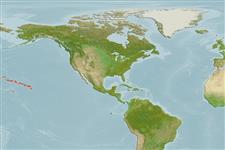Environment: milieu / climate zone / profondeur / distribution range
Écologie
marin benthopélagique; profondeur 5 - 380 m (Ref. 5222). Tropical; 30°N - 11°N, 179°W - 153°W (Ref. 5222)
Eastern Central Pacific: known only from the Hawaiian Islands and Johnston Island.
Taille / Poids / Âge
Maturité: Lm ? range ? - ? cm
Max length : 122 cm TL mâle / non sexé; (Ref. 4887); poids max. publié: 22.7 kg (Ref. 4887)
Épines dorsales (Total) : 11; Rayons mous dorsaux (Total) : 14 - 15; Épines anales: 3; Rayons mous anaux: 9. Distinguished by the following characteristics: juveniles greyish brown to dark brown body color with 8 vertical series of white spots on body; adults dark brown with less distinct vertical series of white spots and obscured by numerous additional pale spots and blotches of variable size; fins mostly unspotted; depth of body contained 2.3-2.7 times in SL, width 2.0-2.5 times in depth; head length 2.3-2.5 times in SL; convex interorbital area, width subequal to eye diameter for fish 10-20cm SL; subangular preopercle, 3-5 enlarged serrae at angle; fleshy ventral edge of preopercle, without serrae; smooth edge of interopercle and subopercle or with a few serrae; convex upper edge of operculum; ovate and enlarged posterior nostrils of adults, larger than anterior nostrils (Ref. 89707).
Body shape (shape guide): fusiform / normal; Cross section: compressed.
Occurs in deep waters (Ref. 7364). Benthic and benthopelagic (Ref. 58302). Feeds mainly on fish and crustaceans (Ref. 89707). A good fish to eat, fleshy, eaten any way except raw (Ref. 7364). Minimum depth from Ref. 122680.
Life cycle and mating behavior
Maturité | Reproduction | Frai | Œufs | Fécondité | Larves
Craig, M.T. and P.A. Hastings, 2007. A molecular phylogeny of the groupers of the subfamily Epinephelinae (Serranidae) with revised classification of the epinephelini. Ichthyol. Res. 54:1-17. (Ref. 83414)
Statut dans la liste rouge de l'IUCN (Ref. 130435: Version 2025-1)
Menace pour l'homme
Harmless
Utilisations par l'homme
Pêcheries: commercial; pêche sportive: oui; Aquarium: Commercial
Outils
Articles particuliers
Télécharger en XML
Sources Internet
Estimates based on models
Preferred temperature (Réf.
123201): 9.3 - 15.3, mean 15.1 °C (based on 3 cells).
Phylogenetic diversity index (Réf.
82804): PD
50 = 0.5000 [Uniqueness, from 0.5 = low to 2.0 = high].
Bayesian length-weight: a=0.01445 (0.00822 - 0.02541), b=3.05 (2.90 - 3.20), in cm total length, based on LWR estimates for this species & Genus-body shape (Ref.
93245).
Niveau trophique (Réf.
69278): 4.0 ±0.67 se; based on food items.
Résilience (Réf.
120179): Faible, temps minimum de doublement de population : 4,5 à 14 années (Preliminary K or Fecundity.).
Fishing Vulnerability (Ref.
59153): High to very high vulnerability (70 of 100).
🛈
Nutrients (Ref.
124155): Calcium = 38.4 [18.1, 76.4] mg/100g; Iron = 0.587 [0.297, 1.119] mg/100g; Protein = 17.3 [15.5, 19.1] %; Omega3 = 0.234 [0.132, 0.418] g/100g; Selenium = 108 [53, 231] μg/100g; VitaminA = 22.3 [7.4, 74.3] μg/100g; Zinc = 0.837 [0.566, 1.273] mg/100g (wet weight);
